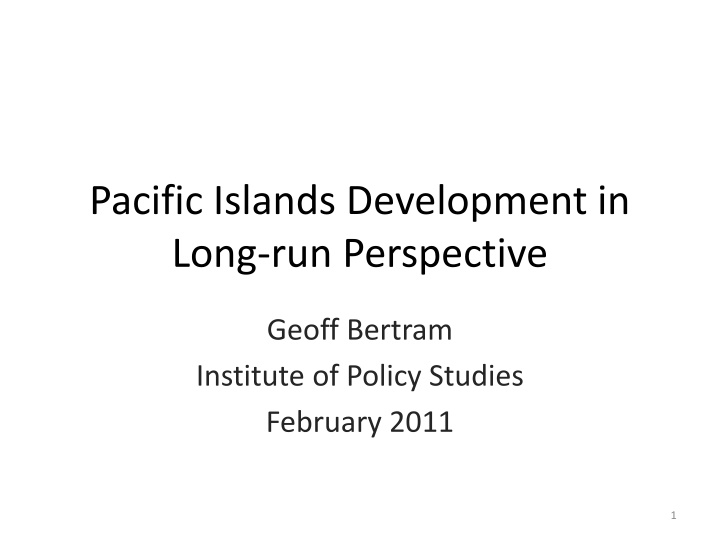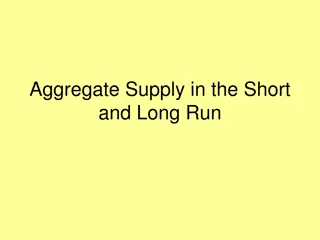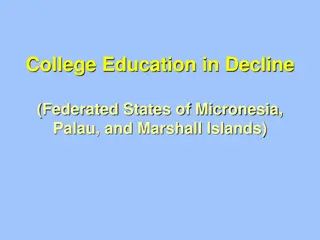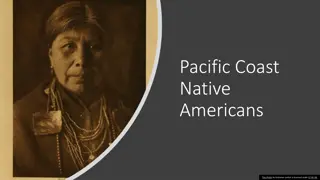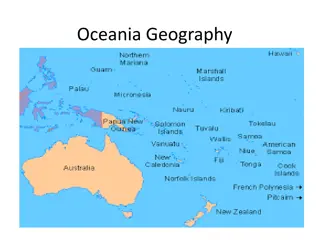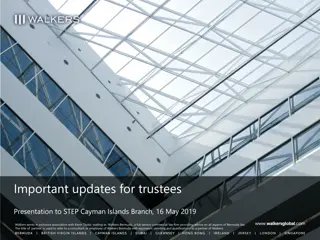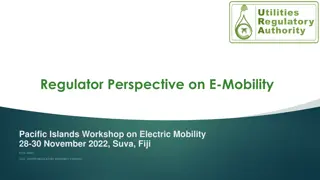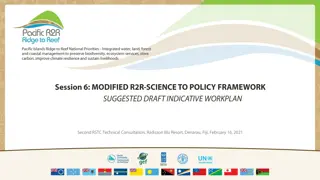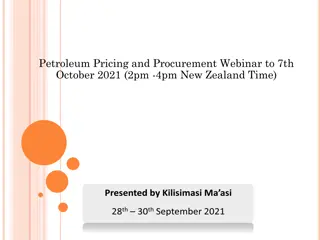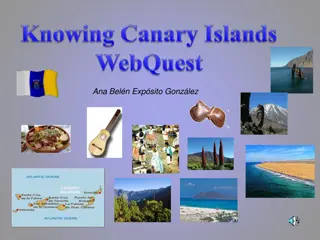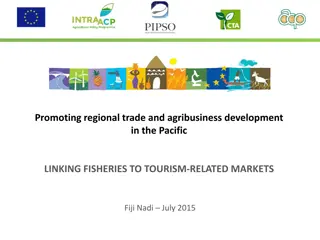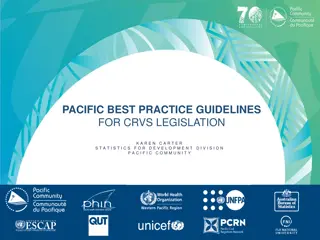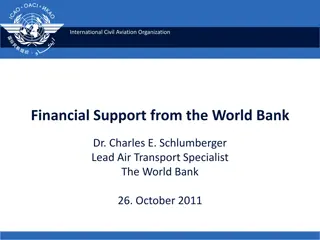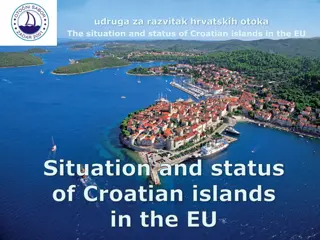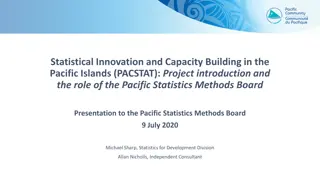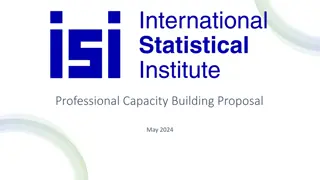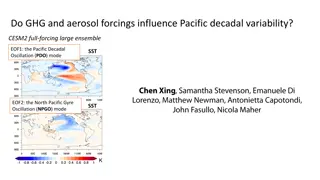Perspectives on Pacific Islands Development in the Long Run
The article discusses the contrast between top-down and bottom-up approaches to resilience in Pacific Island communities, emphasizing the importance of recognizing and nurturing the inherent resilience and adaptability of these societies. It challenges the conventional views imposed by aid agencies and governments, advocating for a more evidence-based and community-oriented approach to sustainable development, with a focus on material welfare, life chances, and cultural identity. The author critiques simplistic notions of development and sustainability, urging a deeper understanding of the complexities involved.
Download Presentation

Please find below an Image/Link to download the presentation.
The content on the website is provided AS IS for your information and personal use only. It may not be sold, licensed, or shared on other websites without obtaining consent from the author.If you encounter any issues during the download, it is possible that the publisher has removed the file from their server.
You are allowed to download the files provided on this website for personal or commercial use, subject to the condition that they are used lawfully. All files are the property of their respective owners.
The content on the website is provided AS IS for your information and personal use only. It may not be sold, licensed, or shared on other websites without obtaining consent from the author.
E N D
Presentation Transcript
Pacific Islands Development in Long-run Perspective Geoff Bertram Institute of Policy Studies February 2011 1
Top-down versus bottom-up Seen from above, resilience is a set of qualities that aid donors want island economies and societies to exhibit outcomes to be purchased. Seen from below, resilience (including adaptability, flexibility, opportunism) has always been the fundamental long-run characteristic of Pacific Island communities, from way back before European contact. Quite a few metropolitan policymakers are still preoccupied with blocking some of the consequences of bottom-up resilience, denying elements of its economic logic, and imposing preconceived (top-down) views of what resilience looks like or should look like A recurrent failing of aid agencies and metropolitan governments is to impose a particular top-down conception of what it means to develop , and to make aid conditional upon a shadow-play of compliance with this vision by the recipients. 2
To get a sense of how bottom-up resilience works, evidence- based analysis is a good place to start Rather than telling island peoples or states how to develop sustainably , or what to develop, watch what they have actually done within the limits of the external constraints placed upon them One early casualty would be the degree of emphasis and expectations placed by large-country analysts on commodity trade and trade agreements. Export-led growth has had a bad century in the Pacific, and the next century s prospects hinge more on regulatory capacity than free-trade treaties Another casualty would be simplistic claims about the benefits of shifting resources from the public sector to the private sector (getting the public sector working more effectively is another matter) Another would be several core assumptions in mainstream development thinking about decolonisation and the virtues of sovereign statehood My own work has tended to focus on gathering comparative numbers and using them to chart the big trends in islander development not only in the Pacific but worldwide. 3
Sustainable development is a term badly in need of careful unpacking. Whenever anyone recommends it or appeals to it they should be asked to explain what exactly is developing , what it means to develop , what mechanism is to do the sustaining , whether this mechanism is politically acceptable or not, and which structural options are being ruled out by use of the term. Unless very specific content is added, the words are mere rhetoric which confuse and conceal. From my perspective, what is to be developed is the material welfare, life chances and cultural identity of each people, seen holistically as a people without regard to national borders unless and until those borders clearly have become effective dividing lines within the people. Development is sustainable so long as material welfare, life chances and cultural cohesion are maintained or enhanced through time without running up large collective balance-sheet liabilities that at some later stage are apt to prove destructive. This means that certain indicators often appealed to in the name of sustainability are in fact often irrelevant especially trade imbalance , capital outflow , brain drain , and that ugly expression, aid dependence . 4
Conceptually one ought to be thinking of viability and sustainability in terms of socioeconomic units often transnational units - rather than national ones. Much of the modern sector of any Pacific island people with migration outlets will lie offshore, inhabited by the diaspora of entrepreneurs and wage-workers which controls a large share of the financial and human capital of the people as a whole. Remittances form a direct cashflow link between the diaspora and the home population, but other links are equally important for long-run growth especially patterns of return migration, back- and-forth visiting, communication via media channels, and accumulation of financial assets in metropolitan banks and share registers. National-accounts aggregates prepared for the home-resident population in isolation not only ignore much of the actual (but offshore) modern sector; they also miss the degree of success in preserving non-material wealth in the form of culture and human capital while raising material welfare. 5
Living standards need not depend upon production in the same locality; they can be fully sustained from sources that look external to the national-accounts statistician, so long as those sources are firmly internal to the transnational ethnic unit. The home-resident pole s living standards become unsustainable only if national borders are used to blockade and divide the people as a whole. The ethnic unit should be accounted on the same P&L and balance-sheet basis as any transnational enterprise. The most obvious gap in the Stiglitz-Sen report on revising the traditional national-accounting framework is that they focus on measuring happiness within geographically-bounded territories rather than for peoples located across multiple territories. 6
A paradox for Adam Smith and Karl Marx: Unproductive Capital is Productive; Productive Capital is Unproductive Infrastructure provided direct use values: schools, hospitals, roads, reef passages, ports, airports, water supply, radio links, government buildings .. Development-project-related capital was moribund, loss- making, often idle The large weight of the public sector in onshore economies is therefore logical, as is the tendency for the private sector to be located offshore in the diaspora, hence off-the-radar in traditional national accounts 7
Migration-adjusted national income accounting (bringing diasporas into the statistics) is in its infancy and is a rich area for empirical macroeconomic research Kenichi Ueda, Kenichi, 2002, Implications of Migration on Income and Welfare of Nationals, International Monetary Fund Working Paper No. 02/215 Roberto Cardarelli and Kenichi Ueda, Domestic and Global Perspectives of Migration to the United States , in United States: Selected Issues, IMF Country Report 04/228,July 2004, pp.16-29. Michael Clemens and Lant Pritchett, Income per Natural: Measuring Development for People Rather than Places , Population and Development Review 34(3): 395-434, September 2008 8
Outline of the rest of the paper How imports are funded (more or less sustainably .) Importance of remittances How population (including labour, human capital, and entrepreneurship) is allocated across geographic space => island peoples, their societies and economies, are transnational in scope Sovereignty is like a tax which places a deadweight burden on prosperity => some sacrifices of sovereignty can have economic and social payoffs Ignoring or downplaying the development experience and performance of sub-national jurisdictions is a big analytical mistake Some long-run charts on New Zealand s relationships with the Pacific 9
In terms of the traditional national-accounts approach, imports rule The ability to fund imports of goods and services is the key means to the end of sustaining private and public consumption, and hence material welfare, within the geographical territory of an island state (including SNJs) Getting the imports at least cost (in terms of leisure and social capital) is the strategic game. There are several ways to work on getting the constraint relaxed in practice. Commodity exports are way down the list, for good reason The place to start is with the relationship of imports to well-being, and the identification of the components of well-being that are not sustainable by imports. Much of the latter has to do with thevillage , its way of life and the problem of how important it is to hold young people in the village economy, and for players in the village to have cash opportunities for sale of products outside. 10
Imports are fundamental to onshore living standards but have to be paid for: Imports and GNI per capita 80 small islands worldwide 100,000 10,000 GNI/GDP per capita US Virgin Islands 1,000 100 Asserted direction of causality 10 1 1.0 10.0 100.0 1,000.0 10,000.0 100,000.0 Imports of goods and services per capita 11
Back in 1984 Ray Watters and I discovered the jaws effect in some small Pacific islands Imports had become disconnected from merchandise exports as the colonial era came to an end 12
Cook Islands trade balance Source: Geoff Bertram, Sustainability, Aid, and Material Welfare in Small Pacific Island Economies, 1900-1990 , World Development, 21,2 (February 1993), p.250.. 13
Niue trade balance 14 Source: Geoff Bertram, Sustainability, Aid, and Material Welfare in Small Pacific Island Economies, 1900-1990 , World Development, 21,2 (February 1993), p.250..
Tokelau trade balance 15 Source: Geoff Bertram, Sustainability, Aid, and Material Welfare in Small Pacific Island Economies, 1900-1990 , World Development, 21,2 (February 1993), p.250..
Tuvalu trade balance 16 Source: Geoff Bertram, Sustainability, Aid, and Material Welfare in Small Pacific Island Economies, 1900-1990 , World Development, 21,2 (February 1993), p.250..
Kiribati trade balance 17 Source: Geoff Bertram, Sustainability, Aid, and Material Welfare in Small Pacific Island Economies, 1900-1990 , World Development, 21,2 (February 1993), p.250..
For us the question this raised was: how was the observed gap being funded Not by overseas borrowing the Pacific has not been a debt- crisis-prone region (the Cook Islands 1988-1996 was the exception to prove the rule) Only in a few cases did services exports pick up the funding burden In the Pacific, a strong commercial balance signals either extreme poverty (PNG, Vanuatu) or special cases (Fiji, American Samoa) 18
How could the trade jaws be sustainable without borrowing to fill the gaps? Our answer in 1984 was MIRAB Two stock-flow relationships were the locomotives of these economies: MIR: Stock of overseas migrants => flow of remittances AB: Flow of aid => stock of public sector employees ( bureaucrats ) 19
60 40 PNG PNG PNG Cook Islands 20 Goods and Fiji American Samoa Services Vanuatu 0 Fiji PNG Vanuatu Fiji Vanuatu Solomons Kiribati Fiji Vanuatu Hawaii Balances of Hawaii Fiji PNG American SamoaAmerican Samoa -20 Fiji American SamoaAmerican Samoa Cook Islands Seventeen Solomons Kiribati Palau Solomons % of imports Vanuatu -40 PNG Pacific Island Kiribati Marshall Islands Kiribati Solomons Samoa Samoa Palau Tonga Solomons -60 Economies FSM Solomons FSM Samoa Tonga Marshall Islands Fr Polynesia Fr Polynesia Tonga Samoa Cook Islands Tuvalu Tonga Marshall Islands Guam Cook Islands 1975-2004 Samoa Cook Islands -80 Tuvalu Guam Cook Islands Tonga Marshall Islands Fr Polynesia Tonga Guam Fr Polynesia Samoa FSM Guam Fr Polynesia -100 FSM Tuvalu -120 Tuvalu -140 Tuvalu -160 1975-79 1980-84 1985-89 1990-94 1995-99 2000-04 20 Source: Geoff Bertram, Economy , in Rapaport, M. (ed) The Pacific Islands: Environment and Society, 2nd ed 2011.
Rule 1: dont get hypnotised by the trade balance (this is the mistake most outside analysts instantly fall into). Commercial trade deficits are common and sustained, therefore (to date at least) sustainable. None of the countries in that diagram has run up unsustainable international debt instead, they have sustained their import capacity by means other than conventional exports. But it s true there is a funding constraint driving the market solutions we observe 21
Theres a solid number of MIRAB cases identified in the literature now Cook and Kirkpatrick (1998): FSM Poirine (1998): French Polynesia, US Virgin Is, Guadeloupe, Martinique, St Perre et Miquelon, Mayotte Bertram (1999): Samoa, Tonga, Easter Island, Palau, Marianas Royle (2001): St Helena, St Kitts, and the Marshall Islands McElroy & Morris (2002): Cape Verde, Comoros, Sao Tome & Principe 22
But MIRAB is on;y one of a rich menu of strategic options: sustainable, but optimal in only a few cases Two dramatic success stories of transition out of MIRAB status are the Cayman Islands and the Cook Islands Consider the Cook Islands case by extending my earlier jaws chart: 23
Cook Islands merchandise trade, real values at 2000 NZ prices 250.0 200.0 NZD million deflated to 2000 prices 150.0 Merchandise imports Merchandise exports 100.0 50.0 0.0 1892 1896 1900 1904 1908 1912 1916 1920 1924 1928 1932 1936 1940 1944 1948 1952 1956 1960 1964 1968 1972 1976 1980 1984 1988 1992 1996 2000 2004 2008 24
Cook Islands: Financing of imports 250.0 200.0 NZD million deflated to 2000 prices Tourism 150.0 Remittances Aid 100.0 Merchandise imports Merchandise exports 50.0 0.0 1892 1896 1900 1904 1908 1912 1916 1920 1924 1928 1932 1936 1940 1944 1948 1952 1956 1960 1964 1968 1972 1976 1980 1984 1988 1992 1996 2000 2004 2008 25
Cook Islands: Financing of imports 250.0 200.0 NZD million deflated to 2000 prices Tourism 150.0 Remittances Aid 100.0 Merchandise imports Merchandise exports 50.0 0.0 1892 1896 1900 1904 1908 1912 1916 1920 1924 1928 1932 1936 1940 1944 1948 1952 1956 1960 1964 1968 1972 1976 1980 1984 1988 1992 1996 2000 2004 2008 26
Cook Islands: Financing of imports 250.0 200.0 NZD million deflated to 2000 prices Tourism 150.0 Remittances Aid 100.0 Merchandise imports Merchandise exports 50.0 0.0 1892 1896 1900 1904 1908 1912 1916 1920 1924 1928 1932 1936 1940 1944 1948 1952 1956 1960 1964 1968 1972 1976 1980 1984 1988 1992 1996 2000 2004 2008 27
Looking around the world there are numerous case studies of island economies which do not exhibit MIRAB characteristics. Baldacchino (2004) and PROFIT. Five dimensions of local jurisdictional autonomy: P (people considerations): powers over movement of persons (including issues of citizenship, residence and employment rights); R (Resource management): powers over environmental policy, especially regarding natural resources; O (overseas engagement and ultra-national recognition):the exercise of para-diplomacy by sub-national governments acting as though they are sovereign states FI : finance, insurance and taxation; T (transportation): powers over access by air and sea. McElroy (2004) and SITEs: small, tourist-dependent islands represent [an analytically] useful cluster or special case of island development. 28
By 2009 Godfrey Baldacchino and I had the following map of the world s islands in terms of how they paid their way*: * From G. Baldacchino and G. Bertram, The beak of the finch: insights into the economic development of small economies , The Round Table, 98, 401 (April 2009), pp.141 160. 29
MIRAB/SITE: MIRAB: SITE: Cape Verde Comoros Dominica Haiti Kiribati Marshall Islands Mayotte Micronesia Montserrat Samoa Sao Tome & Principe St Pierre et Miquelon Tokelau Tonga Tuvalu Wallis & Futuna French Polynesia, Guadeloupe, Martinique, Palau, Pitcairn, Reunion Bali, Bonaire, Canary Islands, Cook Islands, Curacao, Guam, Hawaii, St Maarten, Turks & Caicos SITE/PROFIT Anguilla Antigua & Barbuda Aruba Bahamas Barbados Bermuda British Virgin Islands Cayman Islands Cyprus Fiji Grenada Maldives Malta Marianas Seychelles St Kitts & Nevis St Lucia St Vincent & Grenadines US Virgin Islands Vanuatu SITES MIRABS PROFITs MIRAB/PROFIT: Greenland Nauru New Caledonia Solomon Islands St Helena PROFIT American Samoa, Bahrain, Falkland Islands, Faroe Islands, Guernsey, Iceland, Isle of Man, Jersey, Mauritius 30
Whats special about small-island speciation is that islands make evolutionary switches around the diagram Niches are partly exogenous and partly endogenous (created by strategic behaviour) Selection is partly by chance, but largely by collective response to incentives 31
Sustaining imports requires some source of funding, but not necessarily trade balance with exports ramped up to equal imports. Balance-of-payments current account equilibrium and reasonable living standards can be sustained with very low commodity exports, as Tuvalu dramatically illustrates. Diagnosis requires that the funding flows be identified, quantified, and viewed from a dynamic long-run perspective. A recent attempt at doing this is Bertram and Poirine (2007) 32
Bernard Poirine and I did a number-crunching exercise for 71 island economies to produce a more detailed story* Conclusion: there are many ways to play the game depending what hand has been dealt . (arrows in each diagram identify Pacific economies) Island Political Economy , Chapter 10 in Baldacchino, G. (ed.) A World of Islands, Institute of Island Studies, University of Prince Edward Island, 2007, pp.325-377. 33
Small Island Export Economies at 2000 300 250 200 % of total imports Residual Aid Remittances Tourism Merchandise exports 150 100 50 0 -50 -100 -150 -200 US Virgin Islands Falkland Islands (Islas Solomon Islands American Samoa Northern Marianas Bahrain Faroe Islands Aruba Iceland Nauru Malta 34
Small-island SITEs at 2000 400 300 % of total imports Residual 200 100 Aid 0 Remittances -100 -200 Merchandise exports Tourism -300 British Virgin Islands Turks and Caicos Islands Antigua and Barbuda Cook Islands Cayman Islands Anguilla Maldives Saint Lucia Bahamas, The Guam Mayotte Palau 35
Fully evolved MIRABs at 2000 120 100 % of total imports 80 Residual Merchandise exports Tourism Aid Remittances 60 40 20 0 -20 Tuvalu Tonga Comoros Samoa Cape Verde 36
Small Aid-led island economies at 2000 800 600 400 % of total imports Residual Remittances Tourism Merchandise exports Aid 200 0 -200 -400 -600 -800 Saint Pierre & Miquelon Dominica Timor L'Este Sao Tome & Principe Guadeloupe Martinique Reunion Tokelau Greenland Niue French Polynesia Micronesia Wallis and Futuna Marshall Islands Montserrat 37
Residual-led (= offshore finance) cases at 2000 140 120 100 % of total imports Remittances Merchandise exports Aid Tourism Residual 80 60 40 20 0 -20 -40 Kiribati Bermuda Vanuatu Saint Kitts and Cyprus Nevis 38
Nine strategic orientations: welfare outcomes 2.00 BER CAY BVI ICE HAW 1.80 SIN FAR ARU FAL NZL MAR FRP GUA USV 1.60 GUM CYP NTA ANG CAN MLT Index of income and life expectancy PUE NMI NCA BAH TUR BAR SPM 1.40 GRN SRI DMR HAI CUB SEY ANT STK STV BAH REU STL PAL CKI 1.20 MON MAU JAM FIJ TRI NIU 1.00 STP RMI FSM STH DOM TUV GRE NAU 0.80 MDG SOL WAL TOK MAY MAL TUV VAN 0.60 SAM TGA KIR 0.40 0.20 AMS COM 0.00 Geostrategic rent with exports Offshore finance plus tourism Geostrategic aid Moderate- impact tourism High- value exports High- impact tourism Primary exports with aid and/or remittance support Tourism plus exports Non- geostr- ategic MIRABs Bertram and Poirine 2007: 361 39
Remittances are not everything, but theyre fundamental to some Pacific economies Samoa: the flow of remittances captured by the official statistical agencies is currently around US$50 million (NZ$80 million) a year. Allowing for informal remittances not appearing in the statistics, the true total flow from New Zealand to Samoa probably lies between $100 million and $150 million a year Compare this with New Zealand imports from Samoa of $3-4 million and bilateral aid of $8-9 million a year. Trade and aid, in other words, play only a trivial role in economic relationships between New Zealand and Samoa, while Samoans themselves operate the really important linkage. Tonga: Estimated formal remittances from Tongans in New Zealand are over US$30 million (NZ$50 million), suggesting that the total (including unrecorded transfers) is likely to be in the range $80-100 million a year, Compare this with New Zealand s imports from Tonga of around $2 million and aid of $17 million in 2008. Like Samoa, Tonga s main economic link with New Zealand currently is via remittances. New Zealand s balance of payments statistics provide no estimates of remittance flows! (The Asian Development Bank has called attention to the gap.) 40
How population (including labour, human capital, and entrepreneurship) is allocated across geographic space Island peoples form unified entities spanning transnational space Diasporas are integral parts of many island economies - hence modern sectors , private sectors , skilled employment , etc, occur within the community-defined economy but outside the territorially-delimited nation . The geographic allocation of resources represents a dynamic equilibrium In the labour market, a fundamental piece of information is the income level of the diaspora relative to the income level of the home population. Once corrections have been made for frictional variables, age, level of education and so on, the income relativity between the diaspora and the home labour force should exhibit a threshold differential at which migration accelerates/decelerates. In a migratory equilibrium, the income relativity sits exactly on this threshold. So we should be in a position to estimate income levels of people from a uniform ethnic group across transnational space, and hence to characterise the equilibrium. [For methodological pointers see the work of George Borjas e.g. Imperfect Substitution between Immigrants and Natives: A Reappraisal George J. Borjas, Jeffrey Grogger, and Gordon H. Hanson NBER Working Paper No. 13887, March 2008] 41
In the labour market, a fundamental piece of information is the income level of the diaspora relative to the income level of the home population. Once corrections have been made for frictional variables, age, level of education and so on, the income relativity between the diaspora and the home labour force should exhibit a threshold differential at which migration accelerates/decelerates. In a migratory equilibrium, the income relativity sits exactly on this threshold. We should now be in a position to estimate income levels of people from a uniform ethnic group across transnational space, and hence to characterise the equilibrium. For some methodological pointers see the work of Borjas - e.g. Imperfect Substitution between Immigrants and Natives: A Reappraisal George J. Borjas, Jeffrey Grogger, and Gordon H. Hanson NBER Working Paper No. 13887, March 2008 42
Figure 1 Samoan Community by Place of Residence 600,000 Samoans resident elsewhere in the world 500,000 Other/no detailed data, making up the New Zealand-resident total EthnicSamoan residents of New Zealand born in New Zealand 400,000 300,000 200,000 Ethnic Samoan residents of New Zealand born in Pacific Islands Resident population in Samoa 100,000 0 1906 1911 1916 1921 1926 1936 1941 1945 1951 1956 1961 1966 1971 1976 1981 1986 1991 1996 2001 2006 43
Figure 2 Cook Islands Maori Community by Place of Residence 100,000 Cook Islands migrants elsewhere in the world 90,000 80,000 Other/no detailed data, making up the New Zealand-resident total Ethnic Cook Island Maori residents of New Zealand born in New Zealand Ethnic Cook Island Maori residents of New Zealand born in Pacific Islands Resident population in the Cook Islands 70,000 60,000 50,000 40,000 30,000 20,000 10,000 0 1906 1911 1916 1921 1926 1936 1941 1945 1951 1956 1961 1966 1971 1976 1981 1986 1991 1996 2001 2006 44
Figure 3: Tongan Community by Place of Residence 250,000 Tongan migrants elsewhere in the world Hypothesised missing migrants 200,000 Other/no detailed data, making up the New Zealand-resident total Ethnic Tongan residents of New Zealand born in New Zealand Ethnic Tongan residents of New Zealand born in Pacific Islands Resident population in Tonga 150,000 100,000 50,000 0 1906 1911 1916 1921 1926 1936 1941 1945 1951 1956 1961 1966 1971 1976 1981 1986 1991 1996 2001 2006 45
Figure 4: Niuean Community by Place of Residence 30,000 Niuean migrants elsewhere in the world 25,000 Other/no detailed data, making up the New Zealand-resident total Ethnic Niuean residents of New Zealand born in New Zealand Ethnic Niuean residents of New Zealand born in Pacific Islands Resident population in Niue 20,000 15,000 10,000 5,000 0 1906 1911 1916 1921 1926 1936 1941 1945 1951 1956 1961 1966 1971 1976 1981 1986 1991 1996 2001 2006 46
Figure 5: Tokelauan Community by Place of Residence 10,000 Tokelauan migrants elsewhere in the world 9,000 8,000 Other/no detailed data, making up the New Zealand-resident total EthnicTokelauan residents of New Zealand born in New Zealand Ethnic Tokelauan residents of New Zealand born in Pacific Islands Resident population in Tokelau 7,000 6,000 5,000 4,000 3,000 2,000 1,000 0 1906 1911 1916 1921 1926 1936 1941 1945 1951 1956 1961 1966 1971 1976 1981 1986 1991 1996 2001 2006 47
Figure 6: Tuvaluan Community by Place of Residence 16,000 Tuvalu-born migrants elsewhere in the world 14,000 Other/no detailed data, making up the New Zealand-resident total Ethnic Tuvaluan residents of New Zealand born in New Zealand Ethnic Tuvaluan residents of New Zealand born in Pacific Islands Temporary migrants: seafarers, students, phsophate workers 12,000 10,000 8,000 6,000 4,000 2,000 Resident population in Tuvalu 0 1906 1911 1916 1921 1926 1936 1941 1945 1951 1956 1961 1966 1971 1976 1981 1986 1991 1996 2001 2006 48
Host Countries of the Pacific-Born Diaspora 700,000 600,000 Other countries 185,290 500,000 Others GUM ASM PHL NCL CAN AUS NZL USA 400,000 Australia 99,211 300,000 New Zealand 117,156 200,000 USA 196,838 100,000 0 49
Figure 17: The Migration Transition in Seven Island Communities Proportion of Total Community Living in Home Island(s) 100 90 80 Samoa Tonga Cook Islands Niue Tokelau Fiji Tuvalu 70 % of total 60 50 40 30 20 10 0 1906 1916 1926 1941 1951 1961 1971 1981 1991 2001 50
